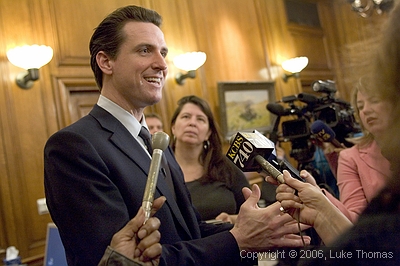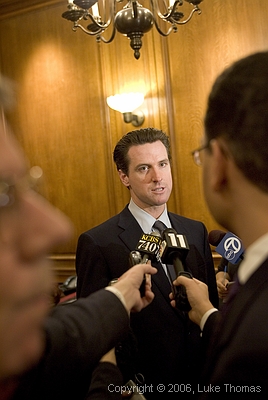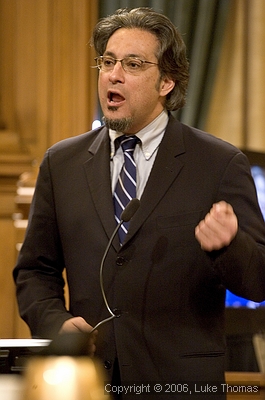Newsom: School closures in struggling neighborhoods
not acceptable

Photo(s) by
Luke Thomas
By Pat Murphy
January 18, 2006
Proposed school closures which disproportionately affect struggling
neighborhoods are unacceptable, Mayor Gavin Newsom said yesterday.
Newsom also predicted early plans to close, merge, or relocate
five Western Addition schools "will be substantially mitigated."
"It is unacceptable that we're in a position where so many
schools that are disproportionately enrolled with African Americans
would be substantially affected," Newsom stated in a 12:15
p.m. City Hall press conference.

His comments came amidst ongoing negotiations leading up to Thursday’s
scheduled decision by the San Francisco School Board on proposed
closures.
Further, the mayor added, he expects a decision on Western Addition
schools will be delayed. Parent groups and Supervisor Ross Mirkarimi
last week asked for a delay and for increased community input
to the decision process.
"I think that consideration is going to take place and that
consideration will be made in terms of delaying any of those decisions
or at least delaying some of those decisions on Thursday,"
Newsom reported.
School District Board President Norman Yee met with Newsom on
the issue Saturday at school district headquarters. Yee declined
additional city funding as forestalling long term solution.
At issue is declining public school enrollment -- which cuts
State funding by $5,000 for every lost enrollment - while the
same number of schools have stayed open.
Each school's funding is based on number of students, with disadvantaged
neighborhood schools most losing revenues due to enrollment drop.
As such, plans to close, merge, or relocate as many as 26 schools
citywide were based on each school's enrollment figures - thereby
hitting hardest those neighborhoods already hard hit.
Three Western Addition schools were closed last year, and five
more are on the block under the current proposal.
Mirkarimi last week led parents in crying foul.
The most vulnerable of San Francisco's children would sense they
are not worth good schooling if more schools are shuttered, Mirkarimi
and parents implored.
They asked more time to find a solution.
Former Mayor Art Agnos noted the top ten School District priorities
do not include a priority for increasing enrollments, and parents
suggested they could devise student recruitment.
And they insisted social impact be considered in the decision
process.
Despite Yee's rejection of the offer, Mirkarimi yesterday introduced
legislation loaning the school district $5.3 million - the amount
of lost State funding.
Both Mirkarimi and Newsom agree $5.3 million is not the actual
amount needed.
"The $5.3 million had no context in the debate and it's
sort of been put out there as if there's a direct correlation,
and I think that's very misleading," Newsom pointed out.
"That's no criticism of Supervisor Mirkarimi - that number
comes directly from the State on the decline in public enrollment,"
explained Newsom.
Mirkarimi acknowledges $5.3 million does not accurately reflect
additional funding needed to keep all schools open.
The actual need is closer to half that amount.
The city already has approved $6.7 million for the school district
to use as it chooses.
Some $4 million of the $6.7 million has been allocated by the
school district.
The remaining $2.7 million could be used to keep schools open,
but since it is discretionary funding Mirkarimi fears the school
board may use it for other needs such as teacher salaries. Contract
negotiations are underway with the teachers union.
Mirkarimi kept to the figure of $5.3 million as means to require
funds be used to keep schools open, he told the Sentinel.
A city committee will hold a hearing Monday on that legislation,
Mirkarimi said, although which committee and time of hearing was
not known by press time.
Newsom explained his role.
"We sat down with the School Board and said, 'What can you
do, what can't you do, what's realistic?' " Newsom recalled.
"It was determined through those meetings that the substantial
number of schools that were being talked about for closure or
merger would not indeed occur this Thursday.
"On that basis when that was determined, and when the School
Board said, 'Thank you but no thank you to more money,' we said,
'Alright let's move forward this Thursday, make the tough decisions
in terms of those schools where there's broad consensus and then
we will be in a position to consider what happens from there.'
"But there needs to be a message sent to particularly those
in the Western Addition community that we are working on this,
and things are going to not transpire in such an acute way as
they otherwise thought."
Newsom echoed Yee's sentiment that short term aid would delay
long term solution.
"If we gave them an additional $5.3 million then the School
Board would not have to make any decision on school closures and
they'd still have a surplus of dollars which inevitably would
be in play in terms of teacher's negotiations," Newsom added.
Newsom's wariness to advance more money is justified, Mirkarimi
said in a press conference prior to the Board of Supervisors meeting.
Even so, a broader picture must be considered, Mirkarimi added,
who represents the District 5 Western Addition.
"His caution is valid by our city government in not advancing
more dollars to use by the Unified School District," Mirkarimi
noted.
"But let's step back a second and remind ourselves how we
got in this position.
"Over the last year...what has come to my attention and
many of my colleagues' attention is what we thought has been a
very flawed process in how closures and mergers had been recommended...what
I thought has been a real chain sawed effect - and not a scalpeled
effect and not measured -- in how closures and mergers would be
administered especially in communities of working class, low-income
and in particular Latino and African American communities.
"I had a very constructive meeting with the mayor yesterday
and with Supervisor Board President Aaron Peskin.
"I think we all agreed and it's affirmed that a better process
for our city and county is needed, but...I still feel that a supplemental
advance...is the appropriate lever to move forward while the Board
of Education is considering the next round of closures.
"The strings that are attached: I want to see a Task Force
which would give a lot of power to the mayor in creating with
the School District a short-term Task Force that looks at how
the school closures or mergers have to occur.
"I understand that this $5.3 million is simply a stay of
execution for lack of a better phrase.
"I do understand that some schools most likely will have
to be closed or merged, but I do not like the trend in which they
were beginning to administer those cuts especially to communities
disproportionately affected.
He also called for development of a five year plan.
"That five year plan would be required to be produced...to
not only understand what the distributed pain would be...due to
declining enrollment, but...what we are going to do to reverse
the trend.
"It's not the children we're just losing to leaving San
Francisco, but we're losing to private schools.
"Thirty percent of our children in San Francisco go to private
schools.
"The fact is that if we're shutting down schools in low-income
communities, in Black and Latino communities et cetera, it's very
likely we're never going to rebuild those schools again - even
if the population increases with families."
With figures flying fast as events, Mikarimi noted he is open
to amending the dollar amount of his supplemental funding ordinance.
"I started with a higher figure because we've heard a variety
of figures, and if the mayor's office feels that there is good
cause, or other members of the Board of Supervisors, to reduce
that figure - or to increase it - then I'm completely open to
that," Mirkarimi offered.
He reiterated his call for public school recruitment before the
Board of Supervisors yesterday afternoon.

Supervisor Ross Mirkarimi
"I want to stop the hemorrhaging for what I think are debatable
reasons, but I also agree with the mayor and I also agree with
other electeds, that what we want are more families with children
in San Francisco to be re-populating all our neighborhoods.
"Maybe this is a perfect intersection to find out how it
is that schools that may be borderline schools of enrollment or
performance that we should not capitulate...and perhaps reinvest
in those communities..."
Although all concerned live in one city -- and children are oblivious
to who delivers the milk - the Mayor's Office, the Board of Supervisors,
and the School Board act from independent perspective.
Yet the mayor is looked to for leadership.
In a speech given at Starr King Elementary School last Thursday,
Newsom related his overview.
Excerpts of that speech follow:
-- I visit San Francisco public schools often and I have seen
what happens in classrooms across this city. There is remarkable
work being done by our committed administrators and teachers as
well as by our dedicated students and parents. However, I recognize
that these are difficult times for the school district. Already
receiving inadequate funding from the State, the district has
also faced continuous, declining enrollment. I understand the
difficulty facing students, families and teachers who are experiencing
disruption and an unknown future for their schools.
-- In order to retain a viable school district, the Board of
Education needs to make hard choices. They must be made based
on sound public policy without political interference. If not,
we will have the same problems every year. I urge the school district
to develop a binding a-political and comprehensive plan that addresses
the long term problems associated with declining enrollment. We
all know that this long term plan must consider demographics of
each school closed and the impact on surrounding communities.
-- The city stands prepared to provide the support required in
this process, including making the city departments and agencies
available to assess factors such as the projected impact of future
housing and economic development on school enrollment.
-- With regards to the current decisions, I believe the district
should consider an appropriate phase-in plan for those schools
closing next fall to lessen the burden of school transfers and
transitions on students and families.
-- I strongly believe that together we can provide a world class
education for all students in all areas of the city.
-- Over the past 40 years, enrollment has decline 40% , from
over 93,000 students to just over 56,000 students today. In fact,
in the last 20 years, the district has lost approximately 10,000
students, a decline of 14%, but it is still operating the same
number of active schools. This imbalance between operating school
sites and enrollment decline must be addressed.
-- Some of our schools are operating at 20% capacity. Four out
of five classrooms are empty. But the district still must provide
a principal, administrative support, facilities and maintenance
as if the schools were operating at a higher capacity. This doesn't
help students, families or teachers.
-- The school district made tough decisions last year by closing
three schools and two child development centers. This year they
also closed the school on Treasure Island and a few years ago
they closed McAteer High School. Since 1997, the San Francisco
Unified School District has opened 11 Charter schools, School
of the Arts Academy, Japanese Bilingual and Bicultural Program
West and two small schools, AIM High Academy and June Jordan.
-- The governor has failed his obligation to support public schools,
but San Francisco as a city has stepped up to support our schools.
We've nearly doubled our support for the schools in the last two
years - from $11.6 million to $21.7 million - and have advanced
an additional $13.3 million this year. This funding invests in
programs that in many cases the school district had to cut - programs
like arts, field trips, athletics, and wellness centers. We also
fund innovative truancy prevention programs, after-school programs
and literarcy programs at schools. This investment is significant
as the city faced its own large budget shortfall and cuts.
####
|